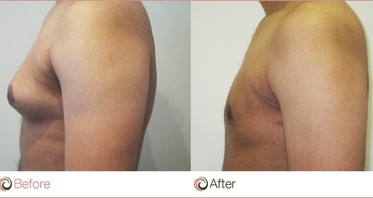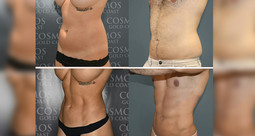Struggling with man boobs (moobs) can be an uncomfortable experience, but it doesn’t have to be a forever problem. Liposuction is a procedure that can reduce excess fat around the chest area, potentially contributing to a flatter appearance. However, individual results may vary and all surgical procedures carry risks, which should be discussed with a qualified healthcare professional. Let us guide you through everything you need to know about liposuction for gynecomastia, including what to expect during and after the procedure.
Summary
- Breast reduction for men –AKA gynecomastia – is a surgery that can help fix overdeveloped or enlarged breasts.
- While the results of the surgery may be long-lasting for many individuals, they can be influenced by factors such as weight gain, hormone levels and imbalances, or the use of certain substances. These factors could potentially affect the longevity of the results.
- If your breast area is enlarged because of obesity, excessive alcohol intake, or poor health, healthy eating and exercise may reduce your large breasts. Often, however, surgery is required.
- A specialist doctor will walk you through the benefits and risks of the surgery, as well as what kind of results you can expect.
If you’re not satisfied with the appearance of your chest, you’re not alone. Many men have excess breast tissue on their chests – also known as gynecomastia – and want to remove these excess fat deposits to achieve a more balanced and less feminine look.
The good news is there are several solutions available to you – from non-surgical to surgical. Diet, exercise and weight loss can be effective solutions for some men, but the results aren’t always permanent.
If you are considering a more long-term approach, liposuction could be one option among others. It is important to consult with a medical professional to understand if this is the most suitable choice for your individual needs and circumstances. Liposuction surgery can remove the fat cells that are causing your enlarged breasts, and the results can be life-changing.
Unsure of the best route for you? In this article, we’ll talk about your options and help you find the best course of action for you to get rid of your man boobs.
How Do You Know If You Have Gynecomastia?
Gynecomastia is a medical condition that can be identified through the presence of palpable, tender, firm, mobile, disc-like mounds of tissue that are located centrally under the nipple-areolar region. While gynecomastia commonly affects both breasts, it can also happen to only one breast or in an uneven manner.
However, if you feel a lump that is hard, doesn’t move, and is away from the nipple, with nipple discharge, or changes to the skin, you should be cautious as this might be breast cancer. It’s important to get checked out by a medical professional, and they might suggest tests like a mammogram or MRI.
What Are the Different Treatment Options?
While in an ideal world reducing body fat, building muscle, and doing chest exercises like bench press and push-ups regularly in the gym would reduce the size of your breasts, it’s never that simple.
While lifestyle changes such as fat loss and reducing your overall body weight may help to reduce breast tissue in men with gynecomastia, it’s often always the best or longest-lasting solution. Medication can often be prescribed as well, and some men will try supplements, but it doesn’t work for everyone.
An effective way to reverse gynecomastia and get rid of excess chest fat is surgery. There are different types of surgery and the right route will depend on your individual situation but liposuction is typically used to remove excess fat, while a mastectomy can be performed to remove glandular breast tissue.
When to Consider Surgery
If your excessive breast tissue is causing physical discomfort and impacting your health, breast reduction surgery may be an option worth considering. This procedure can help reduce the size of your breasts and create a more masculine chest appearance, allowing your chest muscles to shine through (with some dedicated gym time, of course).
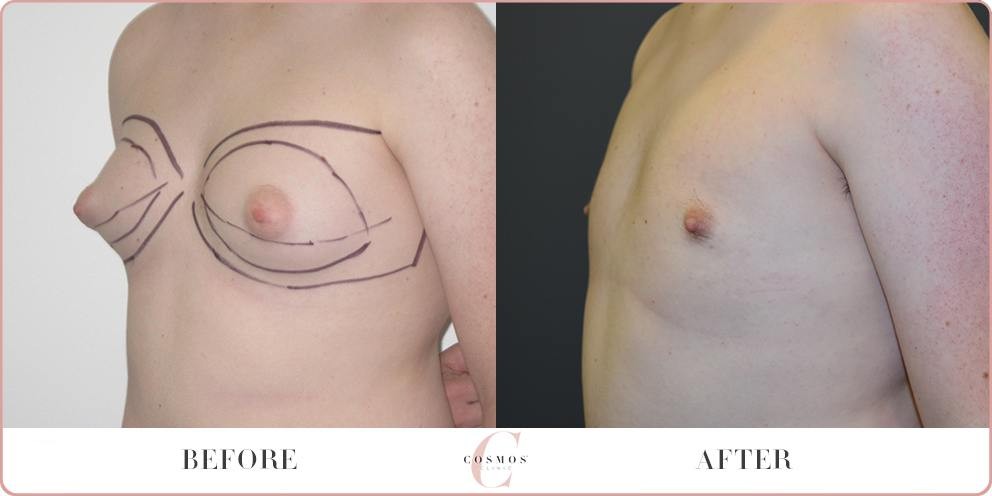
Example of before and after liposuction surgery
It’s important to note that breast reduction surgery is usually recommended for men who have tried lifestyle changes, such as diet and exercise, but have not seen any significant improvement in their breast size or appearance. Also, it’s essential to have a thorough consultation with a qualified
to determine if you’re a suitable candidate for the surgery and to discuss any potential risks and complications.
Ultimately, the decision to undergo breast reduction surgery should be made after carefully weighing the benefits and risks and considering your personal goals and expectations. If you’re unsure whether breast reduction surgery is right for you, it’s best to speak with a qualified medical professional who can provide you with more information and guidance.
Note: At Cosmos Aesthetics, we can discuss your options for addressing man boobs or Gynecomastia (man boobs removal options). However, it’s important to note that if you’re experiencing significant pain or psychological conditions such as depression as a result of Gynecomastia, it is recommended that you seek medical advice.
Things to Consider Before Breast Reduction Surgery
Before undergoing breast reduction surgery, it’s important to consider a few factors:
- Your overall health: Your medical history, medications you’re taking, and other health concerns may affect your eligibility for surgery.
- Your goals: Be clear about your desired outcome and expectations with your doctor.
- Recovery time: Breast reduction surgery can take several weeks to fully recover from, so make sure you have the time and support you need to heal properly.
How to Find the Right Doctor
When considering gynecomastia treatment options, it’s important to choose a qualified and experienced doctor who can help you achieve the best possible outcome. Here are some things to consider when selecting a doctor:
Credentials: Look for a doctor who is certified by a reputable board, such as the Australian Board of Plastic and Reconstructive Surgery. This ensures that the doctor
has completed the necessary training and meets the high standards required for certification.
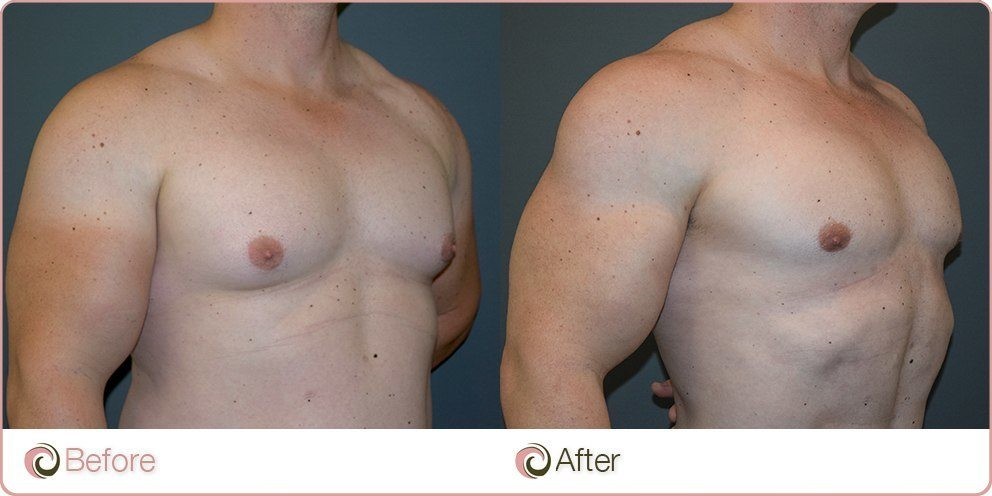
The right doctor will have plenty of before and after pictures
Experience: Choose a doctor who has a track record of successful breast reduction surgeries. Ask for before and after photos of previous patients and read reviews from other patients to gauge their satisfaction with the results.
Consultations: Schedule consultations with potential doctors to discuss your goals and learn about their approach to the procedure. This is an opportunity to ask questions and address any concerns you may have, as well as to get a sense of the doctor’s communication style. A good doctor will take the time to listen to you and develop a personalised treatment plan that meets your specific needs and goals.
Breast Reduction Surgery – What to Expect?
Breast reduction can be done in different ways, depending on your specific needs. Your doctor will talk to you about the best approach for you before your surgery.
If your gynaecomastia is mainly caused by excess fat and fatty tissue, liposuction may be enough to treat it. The procedure involves injecting fluid into the area and using a thin, hollow tube to remove the fat.
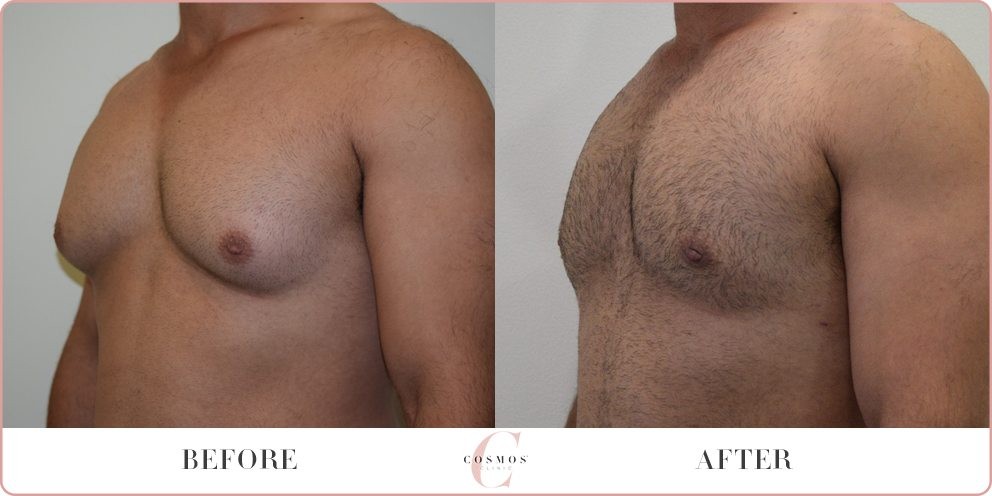
Surgery can give you more define pectoral muscles
However, if you have glandular tissue or excess skin that needs to be removed, your doctor may recommend excision surgery. This involves making incisions to remove the tissue and may be necessary if your areola needs to be reduced or your nipple repositioned. Your doctor will choose the best incision pattern for your situation.
What to Expect Post-Op
Following surgery, there are several things you may experience, but it will vary from person to person. You may experience:
- Bruising and swelling are typical after surgery.
- Some patients may experience numbness.
- Pain and discomfort are to be expected.
- Dressings or bandages will be applied to the affected area.
- Patients who have undergone liposuction may need to wear a compression garment.
How Soon Will You See Results?
After your breast reduction surgery, don’t expect to see results right away. It really depends on the individual, but some people notice an immediate difference while others may experience swelling and bruising for a few weeks. Be patient! It can take several months to see the final outcome. It’s essential to follow your doctor’s instructions and medical advice during this time and attend follow-up appointments for the best results.
Are There Any Complications of Breast Reduction Surgery?
- Risks associated with anaesthesia, including rare cases of allergic reactions that can be fatal
- Surgical risks, such as bleeding or infection
- Blood clots, including deep vein thrombosis, which can lead to a pulmonary embolism or stroke, both of which can be fatal
- Fatal cardiovascular complications, such as a heart attack
- Changes in breast and nipple sensation
- Temporary or permanent numbness in certain areas
- Ripples or sagging skin where liposuction was performed
- Inflamed or itchy scars
- An unevenness of the breasts
- Indentations in the nipple or areola regions
- Skin death (necrosis) along the wound
- Death of nipple tissue
- Death of deeper tissues, such as fat (fat necrosis)
- Possible need for further surgery to treat complications.
Note that this is not a complete list of all possible complications, and your specific medical history and lifestyle may put you at an increased risk for certain complications. You should speak with your medical practitioner to learn more about the risks associated with breast reduction surgery.
Self-Care Post Breast Reduction Surgery
Following breast reduction surgery, it’s important to take care of yourself to ensure a smooth recovery. This may include:
- Wearing compression garments to help with swelling and support your chest area
- Taking prescribed medications as directed
- Avoiding heavy lifting or strenuous activities for several weeks
- Keeping your incisions clean and dry to avoid infection
How Soon Will You Recover?
The recovery period after breast reduction surgery for men can vary depending on the extent of the surgery and the individual’s healing process. Generally, patients can expect to take about a week off from work or other activities to allow their bodies to heal. It’s important to follow your doctor’s post-operative instructions, which may include wearing a compression garment, taking pain medication, avoiding heavy lifting, and refraining from strenuous exercise for several weeks. It’s also important to attend all scheduled follow-up appointments to ensure proper healing and address any concerns that may arise during the recovery period.
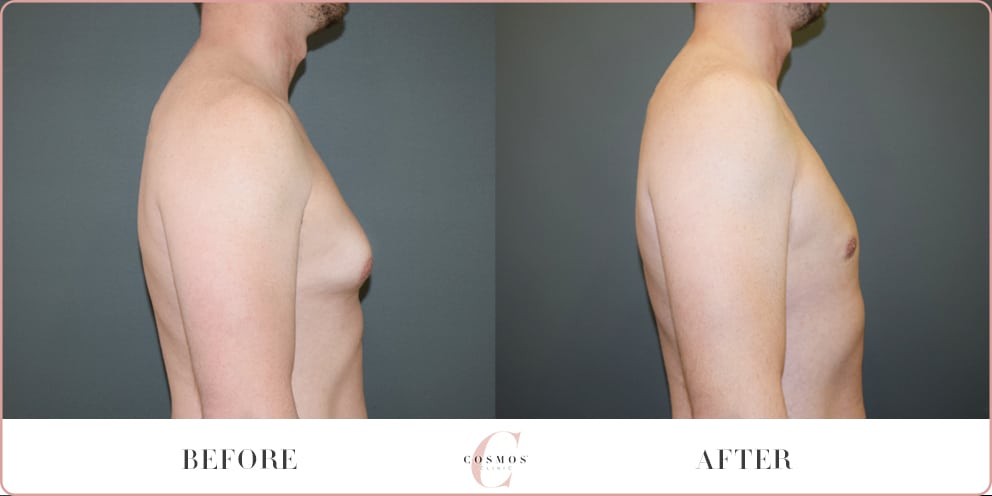
Man boobs can affect all body shapes and sizes
Will There Be Scarring?
To minimise scarring, the doctor will try to hide the incisions in skin creases or at the edges of the areola. Some tissue is usually left behind the nipple to avoid a hollow or “donut” appearance after surgery. This tissue may grow back if substances that cause gynaecomastia are used again after the operation.
Is Breast Reduction Surgery Permanent?
Breast reduction surgery can be life-changing for many men and with proper care, the results of breast reduction surgery can be long-lasting. However, putting on excess body fat and hormonal changes with age may result in the return of large breasts. So, it’s important you maintain a healthy and balanced lifestyle and if you have any concerns about the return of your breasts, speak with your doctor.
Alternatives to Breast Reduction Surgery
While breast reduction surgery is often the most effective treatment for gynecomastia, there are other options to consider. These may include changes to diet and exercise, hormone therapy, or medication.
5 Gym Exercises to Help Reduce Man Boobs
Whether you’re trying to reduce your moobs through exercise alone or want to grow your pecs post surgery, here are 5 gym exercises that may help get you there.
- Push-ups: This classic exercise targets the chest muscles and can help reduce excess fat and tissue in the chest area.
- Chest press: The chest press machine is another effective exercise for targeting the chest muscles and reducing excess fat.
- Dumbbell fly: This exercise targets the chest muscles and can help improve the overall shape of the chest area.
- Incline bench press: This exercise is similar to the chest press, but with an incline, which can help target different areas of the chest and provide a more well-rounded workout.
- Cardio: Incorporating cardiovascular exercises, such as running, cycling, or swimming, into your routine can help burn overall body fat, including in the chest area.
Where to Get Help
If you’re struggling with gynecomastia and considering breast reduction surgery, it’s important to seek out a qualified medical practitioner who can help guide you through the process. Talk to your doctor or do some research online to find a reputable doctor in your area.
- Your GP (doctor)
- A medical practitioner specially trained and experienced in performing cosmetic surgery
- Cosmetic surgery hub and hotline, Australian Health Practitioner Regulation Agency (AHPRA)
- Cosmetic surgery, Department of Health and Aged Care, Australian Government
- Australian Society of Plastic Doctors
- Royal Australasian College of Doctors
- Australian Health Practitioner Regulation Agency (AHPRA)
Male Breast Reduction Surgery FAQs
1. What is breast reduction surgery for men?
Breast reduction surgery for men, also known as gynecomastia surgery, is a procedure that removes excess breast tissue, fat tissues, and skin from the chest area to create a flatter, more masculine chest.
2. Who is a good candidate for breast reduction surgery?
Men who have enlarged or overdeveloped breasts due to hormonal imbalances, genetics, weight gain, or certain medications may be good candidates for breast reduction surgery. Good candidates are typically in good overall health, have realistic expectations about the outcome, and are not currently smoking.
3. What happens during breast reduction surgery for men?
The specific techniques used during breast reduction surgery for men may vary depending on the individual’s needs and preferences. Generally, the doctor will make incisions around the areola and/or under the chest to access the excess breast tissue and fat, which may be removed through liposuction or surgical excision. The doctor may also reposition the nipples and resize the areolas as needed.
4. What is the recovery process like after breast reduction surgery for men?
After the surgery, patients can expect some bruising, swelling, and discomfort in the chest area. They may need to wear a compression garment for several weeks to support the healing process. Most patients are able to return to work and light activities within a week or two, but more strenuous activities should be avoided for several weeks.
5. What are the potential risks and complications of breast reduction surgery for men?
As with any surgery, there are potential risks and complications associated with breast reduction surgery for men. These may include bleeding, infection, anaesthesia risks, changes in nipple or breast sensation, scarring, asymmetry, and the need for additional surgeries. However, these risks can be minimised by choosing a qualified and experienced doctor and carefully following all pre and post-operative instructions.
6. Will breast reduction surgery for men leave noticeable scars?
It is possible to have some scarring after breast reduction surgery for men, but the scars typically fade over time and can be concealed with clothing. The doctor will make every effort to minimise scarring and may recommend scar treatment options such as silicone sheets or ointments.
7. How long does it take to see the results of breast reduction surgery for men?
The initial results of breast reduction surgery for men are typically visible immediately after the procedure, but the final results may take several months to fully develop as the chest area heals and settles into its new shape.
8. Are man boobs caused by high testosterone levels or high estrogen levels?
Man boobs, or gynecomastia, can be caused by a variety of factors, including hormonal imbalances. In some cases, high oestrogen levels relative to testosterone can contribute to the development of gynecomastia. However, it is important to note that there are many other underlying causes, such as obesity, side effects to certain medications, and medical conditions.
Related posts

